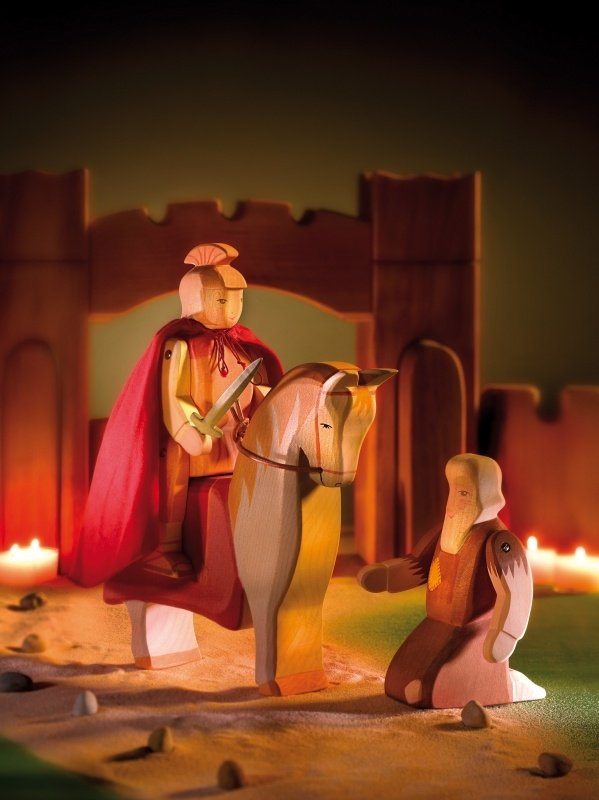Soldiering
Beauséant and Buckler—1 November AD 2022
Scripture Passage: “He maketh wars to cease unto the end of the earth; He breaketh the bow, and cutteth the spear in sunder; He burneth the chariot in the fire. Be still, and know that I am God: I will be exalted among the heathen; I will be exalted in the earth.” —Psalm 46:9-11
Challenge Message: “For some reason, the most vocal Christians among us never … demand that the Sermon on the Mount, the Beatitudes, be posted anywhere. ‘Blessed are the merciful’ in a courtroom? ‘Blessed are the peacemakers’ in the Pentagon? Give me a break!” —Kurt Vonnegut
Martinmas
Most folks with an aptitude for history know that Veterans Day used to be called Armistice Day, commemorating the eleventh hour of the eleventh day of the eleventh month of the year 1918, when the armistice ending major hostilities in World War I took effect. Far fewer recall the reason why that specific date, 11 November, had been chosen to close out the most destructive conflict in human history up to that point. For this we must look to an older holiday, and to one soldier in particular.
St Martin of Tours, also known as Martin the Merciful, was born in Pannonia, a central European province of the Roman Empire, in the early fourth century. His father was a tribune in the Legions, awarded the status of veteran and the 160 acres of Italian land that came with it. At the age of 10, Martin became a Christian catechumen against his parents’ wishes. Christianity had only recently been legalized, and remained far from accepted amongst the upper echelons of Western Roman society.
As the son of a veteran officer, Martin was required to join the cavalry at 15 years of age. By 18, he found himself stationed in Gaul, modern day France. It appears by then that he’d been assigned to the Emperor’s elite mounted bodyguard. Here the most famous incident of his life occurred, at the gates of Amiens. The residents of the city were hunkering down for an oncoming winter storm, when Martin noticed a beggar at the city gate. This beggar had no cloak, no blanket. He would surely freeze in the night.
Impulsively, Martin took his own military cloak and cut it in twain with his sword, handing one piece to the beggar. That night, wrapped in the other half, Martin had a dream of Jesus Christ standing before the assembled saints and angels of Heaven, holding aloft the half-cloak and proclaiming, “See how Martin the solider has clothed Me!” Come morning, Martin immediately set out to search for the beggar—who had vanished without a trace. Still but a catechumen, Martin immediately sought Baptism.
The rest, as they say, is history; or at least hagiography. Martin became a monk and disciple of Hilary of Poitier. He confronted the devil and converted brigands. He defended the divinity of Christ against the Arianism of the imperial court. He won his mother to the faith, though his father proved a bit more hard-nosed. Mercies and miracles followed in his wake wheresoever he trod. Officials often refused to see him because they knew that he would demand amnesty for some prisoner, and they would find themselves unable to decline.
Eventually Martin became Bishop of Tours, the diocese now a part of his name. At 45 he confronted the pagan Emperor Julian the Apostate, telling him, “I am a soldier of Christ. It is not lawful that I should fight.” Charged with cowardice, he volunteered to travel to the front unarmed, yet before he could get there the invaders sued for peace. Today Martin is revered as the patron saint not only of soldiers but also of soldiers-turned-peacemakers. And while few today remember his feast day on 11 November, a century ago, at the close of the Great War, all of Europe knew the significance of Martinmas.
His influence continues in subtler ways as well. That famous half-cloak of his became a sacred relic carried about by the Kings of France as they traversed their realm. When the royal retinue would bed down for the night, this cloak would be housed in little shrines along the road, which came to be called “chapels”—after capella, the word for “little cloak.” Since these chapels were used by nobles on the move, Vespers services consisted of the unaccompanied human voice. Today we call such singing “a cappella,” or “from the chapel.”
Martinmas festivities today, in those parts of Europe which still celebrate the feast, coincide with the autumn harvest, livestock slaughter, and the tapping of beers and wines. The night before involves bonfires, and children processing through the dark with paper lanterns, singing and earning treats. Thus the holiday rather strikes one as a blend of the American celebrations of Halloween and Thanksgiving, between which it falls.
Yet the message at the heart of it all is peace, ever peace: the peace of God which passeth all understanding. May wars cease in all the earth. May the knight never need to unsheathe his sword. May we know the blessings of God, love for our neighbors, and prosperity shared by all of humankind.
In Jesus. Amen.

I have told many versions of St Martin's story over the years. Honestly, my favorite title for a Martinmas sermon was "Knight to Bishop." I just thought I was being so dang cute.
ReplyDelete